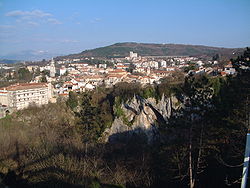Pazin
| Pazin | |||
|---|---|---|---|
| City | |||
|
Grad Pazin City of Pazin |
|||

Panorama
|
|||
|
|||
| Location of Pazin within Croatia | |||
| Coordinates: 45°14′25″N 13°56′12″E / 45.24028°N 13.93667°ECoordinates: 45°14′25″N 13°56′12″E / 45.24028°N 13.93667°E | |||
| Country |
|
||
| County |
|
||
| Government | |||
| • Mayor | Renato Krulčić (IDS) | ||
| Area | |||
| • City | 134.87 km2 (52.07 sq mi) | ||
| Elevation | 277 m (909 ft) | ||
| Population (2011) | |||
| • City | 8,638 | ||
| • Density | 64/km2 (170/sq mi) | ||
| • Urban | 4,386 | ||
| Time zone | CET (UTC+1) | ||
| • Summer (DST) | CEST (UTC+2) | ||
| Postal code | 52 000 | ||
| Area code(s) | 052 | ||
| Vehicle registration | PU | ||
| Website | pazin.hr | ||
Pazin (Italian: Pisino, German: Mitterburg) is a city in western Croatia, the administrative seat of Istria County. It is known for medieval Pazin Castle, the former residence of the Istrian margraves.
The town had a population of 8,638 in 2011, of which 4,386 lived in the urban settlement. In 1991 it was made the capital of the county for its location in the geographical centre of the Istria peninsula and in order to boost the development of its interior territories.
Pazin was first mentioned as Castrum Pisinium in a 983 deed regarding a donation by Emperor Otto II to the Diocese of Poreč. It then belonged to the Imperial March of Istria, which had originally been under the suzerainty of the newly established Duchy of Carinthia in 976, but separated together with the March of Carniola in 1040.
In the 12th century Mitterburg Castle was in possession of the Lower Carniolan count Meinhard of Schwarzenburg, who held the office of a vogt of the Poreč bishops (in Latin documents he is known as Cernogradus), and established the Pazin County (earldom). Upon his death, Pazin was inherited by his son-in-law Count Engelbert III of Gorizia (Görz) in 1186.
The Istrian contract (Razvod istarski) was written in 1325 in the Croatian language and in the Glagolitic script.
While most of Istria had gradually been annexed by Venice, Engelbert's descendant Count Albert III of Gorizia in 1374 bequested his Mitterburg estates to the Austrian House of Habsburg, who attached them to their Duchy of Carniola and gave it out in fief to various families, the last of which was the comital House of Montecuccoli from 1766. Until 1918, the town (under the name Pisino) was part of the Austrian monarchy (Austrian side after the compromise of 1867), seat of the district of the same name, one of the 11 Bezirkshauptmannschaften in the Austrian Littoral province.
...
Wikipedia



